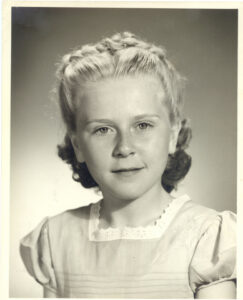NOT in the slow lane YET
The blog is about living life after 70 with joy, resilience, and purpose. NOT in the slow lane YET is a source of positive, helpful advice, encouraging people to set and achieve goals and find joy in life. The blog will cover personal experiences, thoughts, and concerns. Topics of blogs will include health, retirement, fashion, travel, and living in continuing care retirement communities. The blogs will be short and appear at least once a month on my website www.nadineblock.com or by email if you choose.
“It’s just like riding a bike. It is easy, and you will never forget.”

Learning to ride a bike was not easy! A big deterrent to riding my new bike in the late 1940s was our farm driveway. It was long, gravelly, and narrow. I was a skinny 10-year-old farm girl with modest skill in driving a tractor, but no experience riding the big bicycle my parents had bought for me. It stubbornly refused to go straight, and I was soon in the gravel. My knees were skinned and scabbed. New wounds developed on top of them. Fortunately, I did not fall on my head. I did not wear a helmet.
I discovered that riding a bike was not as easy as I thought, and I had forgotten how to ride one in my old age. “Just like riding a bike. It is easy, and you will never forget,” did not work for me.
I stood on a big bucket next to the bike, threw my leg over the bar, and pushed off. All in one motion, I was supposed to balance, pedal, and steer. It was daunting. I usually headed for the grassy ditch when I got wobbly. I was hopeless but inspired to learn because my best friend lived a mile away, and a bike was better than walking to visit her. I had to learn how to ride a bike.
I do not know why I had a boy’s bike. I was the oldest of five children. Did my parents think that a boy’s bike would hold up better and would last for all five children? The horizontal bar makes a triangle, structurally stronger than a girl’s bike. Girls’ bikes had an open bar that accommodated dresses. I am sure that was not a consideration in buying a bike for this farm girl. I wore long pants or shorts. I usually wore two pairs of long pants when I was learning to ride a bicycle.
Typically, children learn to ride a bike between the ages of 3 and 5. Why did I learn to ride a bike at the old age of ten? Bikes were not readily available in my childhood. World War II (which ended in 1945) slowed or halted the production of consumer goods, like bicycles, to make war materials, like tanks, airplanes, and jeeps. That may be why I was already 10 years old and had not learned to ride a bike.
My siblings giggled at my awkwardness. A couple of them thought they could do better. I was the oldest child, the guinea pig, on whom Mom and Dad tried out their parenting skills. They taught me to take care of and teach siblings what I knew. I was determined I would show them I could do it. It seemed like it took forever, but I finally felt the joy of conquering the bike.
Today, parents teach children to ride bikes with helmets to protect their heads. Balance bikes are sized to them without pedals or pedals are removed. Children propel the bike by pushing their feet against the ground. Pushing forward with their feet helps them learn balance and coordination before they start pedaling. They glide farther each time, gaining balance and coordination. They stop by dragging their feet to come to a halt. Then they move on to pedals with balance and coordination partly learned, ready for a smooth ride. Today, girls’ bikes are made of strong, lightweight materials and proportioned to fit their bodies. They have narrower handlebars and more comfortable saddles. It is easier than my bike adventure in the 1940s!
I did minimal cycling in my adult life. In my late seventies, I attended a family event on Fire Island, New York. We decided to take an after-dinner bike ride on wooden boardwalks.
I thought, “I can do it. It is just like riding a bike. It is easy, and you will never forget.” I was wrong. It was almost dark. I missed a turn and fell off the bike into the bushes. My elderly body with shaky balance and inadequate coordination had trouble remembering how to ride a bike.
I walked the bicycle and my bruised ego back to the cottage. It was my last time riding a bike.
Maybe I could try to erase my “learning to ride a bike memory” by starting over with an adult Balance bike. Wouldn’t I be a sight on my Balance bike in my senior retirement community?
There would be a “knock knock” on my door. The Shady Rest social worker would greet me with, “Shall we talk about assisted living or memory care for you?”
Note: Co-pilot editing tools used 9-20-25